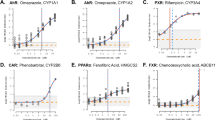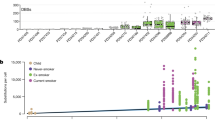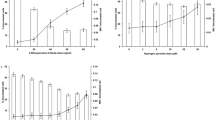Abstract
BOYLAND1 has suggested that 90% of cancer in man is caused by chemicals, either endogenous or environmental. The association of human cancer with hydrocarbons dates from Percival Pott's description of chimney sweeps' cancer in 1775, greatly reinforced by the isolation 150 yr later of benzo(a)pyrene from coal tar by Kennaway2 and his associates3. Although there are probably many unidentified carcinogens in soot and coal tar, the correlation between the experimental production of cancer in animals with pure hydrocarbons and the incidence of cutaneous cancer in people exposed to tar, pitch, soot, oil and similar industrial products4 is suggestive. It is much more difficult to assess the relevance of hydrocarbons to human cancer at other sites, and, in particular, their role in the induction of lung cancer remains unresolved.
This is a preview of subscription content, access via your institution
Access options
Subscribe to this journal
Receive 51 print issues and online access
$199.00 per year
only $3.90 per issue
Buy this article
- Purchase on Springer Link
- Instant access to full article PDF
Prices may be subject to local taxes which are calculated during checkout
Similar content being viewed by others
References
Boyland, E., Prog. Exp. Tumour Res., 11, 222 (1969).
Kennaway, E. L., Brit. Med. J., ii, 749 (1955).
Cook, J. W., Hewett, C. L., and Hieger, I., J. Chem. Soc., 395 (1933).
Henry, S. A., Brit. Med. Bull., 4, 389 (1947).
Brookes, P., Cancer Res., 26, 1994 (1966).
Brookes, P., and Lawley, P. D., Nature, 202, 781 (1964).
Brookes, P., and Dipple, A., in Physico-Chemical Mechanisms of Carcinogenesis (edit. by Bergmann, E. D., and Pullman, B.), 139 (Israel Academy of Sciences, Jerusalem, 1969).
Diamond, L., Defendi, V., and Brookes, P., Cancer Res., 27, 890 (1967).
Diamond, L., Sardet, C., and Rothblat, G. H., Intern. J. Cancer, 3, 838 (1968).
Andrianov, L. N., Belitsky, G. A., Ivanov, O. J., Khesina, A. Y., Khitrovo, S. S., Shabad, L. M., and Vasiliev, J. M., Brit. J. Cancer, 21, 566 (1967).
Duncan, M., Brookes, P., and Dipple, A., Intern. J. Cancer, 4, 813 (1969).
Diamond, L., J. Cell. Comp. Physiol., 66, 183 (1965).
Diamond, L., Prog. Exp. Tumour Res., 11, 364 (1969).
Diamond, L., Defendi, V., and Brookes, P., Exp. Cell Res., 52, 180 (1968).
Duncan, M., and Brookes, P., Intern. J. Cancer, 6, 496 (1970).
Miller, J. A., Cancer Res., 30, 559 (1970).
Dipple, A., Lawley, P. D., and Brookes, P., Europ. J. Cancer, 4, 493 (1968).
Berwald, Y., and Sachs, L., J. Nat. Cancer Inst., 35, 641 (1965).
DiPaolo, J. A., Nelson, R. L., and Donovan, P. J., Science, 165, 917 (1969).
Chen, T. T., and Heidelberger, C., Intern. J. Cancer, 4, 166 (1969).
Author information
Authors and Affiliations
Rights and permissions
About this article
Cite this article
BROOKES, P., DUNCAN, M. Carcinogenic Hydrocarbons and Human Cells in Culture. Nature 234, 40–43 (1971). https://doi.org/10.1038/234040a0
Received:
Issue Date:
DOI: https://doi.org/10.1038/234040a0
This article is cited by
-
Some properties of the chloramphenicol resistance transposon Tn9
Molecular and General Genetics MGG (1979)
-
The construction and replication properties of hybrid plasmids composed of the r-determinant of R100.1 and the plasmids pCRI or pSC201
Molecular and General Genetics MGG (1979)
-
Drug resistance plasmids
Molecular and Cellular Biochemistry (1979)
-
Mapping of the resistance genes of the R plasmid NR1
Molecular and General Genetics MGG (1978)
Comments
By submitting a comment you agree to abide by our Terms and Community Guidelines. If you find something abusive or that does not comply with our terms or guidelines please flag it as inappropriate.



